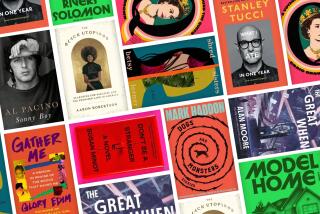Ripping Her Own Bodice : COCO, THE NOVEL <i> by Patricia B. Soliman (G.P. Putnam’s Sons: $21.95; 399 pp.) </i>
“Coco, the Novel” is a good argument against dying.
With death--in this case, fashion icon Coco Chanel’s--a private life enters the public domain, free to become the stuff that novels are made of. And not necessarily great novels--novels that take the events of a lifetime, compress them, reshape them and serve them anew with a few interpretive social flavorings.
Who was Coco Chanel? As portrayed “Coco: The Novel” she was a veritable superwoman: a workaholic, a natural horsewoman, a crack shot and a raven-haired beauty with boundless ambition and the determination never to be possessed by a man. She had a designing eye for the simple, yet her life was far from uncomplicated. She was lucky at gaming tables but, for the most part, unlucky at love. The perfect stuff of novels.
Patricia B. Soliman presents her fictional portrait of Coco, from age 17 to her death, through narration in Coco’s voice and the voices of her confidants and lovers. Alas, one failing of the book is that the voices have little to distinguish them. Each new voice introduces itself with a little personal history, then launches into a “the first time I saw Coco” reverie. It makes for slow going in the early chapters.
The book jacket explains that Soliman, an editor for two decades, now has switched literary hats. She knows the tricks of the literary craft. It’s all technically correct, but it lacks inspiration.
After failing in her ambition to become a star of the stage, our little dark-haired Gabrielle evolves into Coco and eases into dressmaking, millinery and a love affair with a rich man. That affair is followed by another love affair with another rich man. Unfortunately, due to the compression of events, all this and World War I go by in the blink of an eye. Somewhere in the midst of all this, chere petite Coco opens her couture business in Paris (with a little help from her the second rich lover, Boy Capel), expands to Deauville, liberates women from corsets and raises hemlines to ankle-baring heights. Mon dieu!
On occasion, the novel manages to suggest passion. A few of the scenes summon up the romantic intensity of an earnest bodice-ripper. One imaginative scene creates a metaphor between lovemaking and Coco’s penchant for pearls (and that’s all I can say in a family newspaper).
The later chapters have more vitality. Perhaps by then Soliman had a greater familiarity with her characters; perhaps the terrain felt less foreign.
By this time, Coco is running with the rich and the famous and the notorious and the artsy. The name-dropping gets serious: Picasso, Cocteau, Diaghilev, Stravinsky, Winston Churchill. After pages of events and openings and balls and what-nots, we find ourselves with a mature Coco of 37. Suddenly, in middle life after years of liaisons, Coco is concerned with her fertility. Is that the old ticktock of the biological clock we hear?
Still, her life seems a little too effortless. (Yeah, I know Coco was lonely and suffered from insomnia, but she also had a seemingly endless string of lovers and lots of money.) Soliman’s idea, no doubt, is that Coco was an original--that she just was . But if I’m going to buy a hardcover and spend the time it takes to read nearly 400 pages, I want to have an understanding or at least a good guess--as to who or what the woman was.
What we get instead is a woman allegedly fiercely driven to independence but who just couldn’t stop attracting men (and a few women) who wanted to possess her. For all her independence, our Coco was a prisoner of love.
In fact, Soliman chose a Chanel quote to set the book’s tone: “Great loves, too, must be endured.” The same could be said for portions of this novel.
So, chers amis, if you are curious about Coco Chanel the person, pick up a biography. If, however, you’re interested in the more romanticized version, this is the book for you. It’s suitable for pool-side or airplane reading. Only, wait for the paperback.
More to Read
Sign up for our Book Club newsletter
Get the latest news, events and more from the Los Angeles Times Book Club, and help us get L.A. reading and talking.
You may occasionally receive promotional content from the Los Angeles Times.






